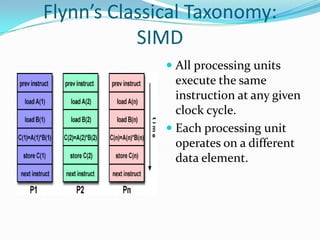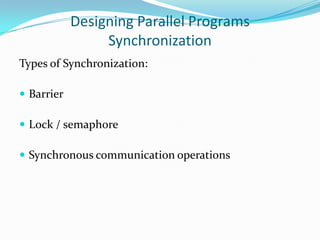Parallel computing
Parallel computing is the simultaneous use of multiple compute resources to solve a computational problem faster. It allows for larger problems to be solved and provides cost savings over serial computing. There are different models of parallelism including data parallelism and task parallelism. Flynn's taxonomy categorizes computer architectures as SISD, SIMD, MISD and MIMD based on how instructions and data are handled. Shared memory and distributed memory are two common architectures that differ in scalability and communication handling. Programming models include shared memory, message passing and data parallel approaches. Design considerations for parallel programs include partitioning work, communication between processes, and synchronization.



























Recommended




























































More Related Content
What's hot (20)










































Similar to Parallel computing (20)








































Parallel computing
- 1. Parallel Computing Submitted by: •Virendra Singh Yadav •
- 2. Overview What is Parallel Computing Why Use Parallel Computing Concepts and Terminology Parallel Computer Memory Architectures Parallel Programming Models Examples Conclusion
- 3. What is Parallel Computing? Parallel computing is the simultaneous use of multiple compute resources to solve a computational problem.
- 5. Why Use Parallel Computing? Saves time Solve larger problems Cost savings Provide concurrency
- 6. Concepts and Terminology: Types Of Parallelism Data Parallelism Task Parallelism
- 7. Concepts and Terminology: Flynn’s Classical Taxonomy Distinguishes multi-processor architecture by instruction and data SISD – Single Instruction, Single Data SIMD – Single Instruction, Multiple Data MISD – Multiple Instruction, Single Data MIMD – Multiple Instruction, Multiple Data
- 8. Flynn’s Classical Taxonomy: SISD Serial Only one instruction and data stream is acted on during any one clock cycle
- 9. Flynn’s Classical Taxonomy: SIMD All processing units execute the same instruction at any given clock cycle. Each processing unit operates on a different data element.
- 10. Flynn’s Classical Taxonomy: MISD Different instructions operated on a single data element. Example: Multiple cryptography algorithms attempting to crack a single coded message.
- 11. Flynn’s Classical Taxonomy: MIMD Can execute different instructions on different data elements. Most common type of parallel computer.
- 12. Parallel Computer Memory Architectures: Shared Memory Architecture All processors access all memory as a single global address space. Data sharing is fast. Lack of scalability between memory and CPUs
- 13. Parallel Computer Memory Architectures: Distributed Memory Each processor has its own memory. Is scalable, no overhead for cache coherency. Programmer is responsible for many details of communication between processors.
- 14. Parallel Programming Models Shared Memory Model Messaging Passing Model Data Parallel Model
- 15. Parallel Programming Models: Shared Memory Model In the shared-memory programming model, tasks share a common address space, which they read and write asynchronously. Locks may be used to control shared memory access. Program development can be simplified since there is no need to explicitly specify communication between tasks.
- 16. Parallel Programming Models: Message Passing Model
- 17. Parallel Programming Models: Data Parallel Model
- 18. Designing Parallel Programs Patitioning - Domain Decomposition • Functional Decomposition • Communication • Synchronization
- 19. Partition : Domain Decomposition Each task handles a portion of the data set.
- 20. Partition Functional Decomposition Each task performs a function of the overall work
- 21. Designing Parallel Programs Communication Synchronous communications are often referred to as blocking communications since other work must wait until the communications have completed. Asynchronous communications allow tasks to transfer data independently from one another.
- 22. Designing Parallel Programs Synchronization Types of Synchronization: Barrier Lock / semaphore Synchronous communication operations
- 23. Example: As a simple example, if we are running code on a 2- processor system (CPUs "a" & "b") in a parallel environment and we wish to do tasks "A" and "B" , it is possible to tell CPU "a" to do task "A" and CPU "b" to do task 'B" simultaneously, thereby reducing the runtime of the execution.
- 24. Example: Array Processing Serial Solution Perform a function on a 2D array. Single processor iterates through each element in the array Possible Parallel Solution Assign each processor a partition of the array. Each process iterates through its own partition.
- 25. Conclusion Parallel computing is fast. There are many different approaches and models of parallel computing.
- 26. References https://computing.llnl.gov/tutorials/parallel_comp Introduction to Parallel Computing, www.llnl.gov/computing/tutorials/paralle l_comp/#Whatis www.cs.berkeley.edu/~yelick/cs267- sp04/lectures/01/lect01-intro http://www-users.cs.umn.edu/~karypis/parbook/
- 27. Thank You